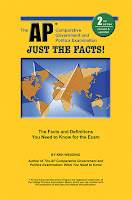Be careful what you wish for
Chinese leaders must be nervous. The last time youthful protests were widespread, they ended only after the army killed hundreds of protesters in Tiananmen Square. The army moved in when workers began joining students in the protests.
China’s Leaders Confront an Unlikely Foe: Ardent Young Communists
Teaching Comparative blog entries are indexed. Use the search box to look for country names or concept labels attached to each entry.
 Just The Facts! 2nd edition is a concise guide to concepts, terminology, and examples that will appear on May's exam.
Just The Facts! 2nd edition is a concise guide to concepts, terminology, and examples that will appear on May's exam.
Just The Facts! is available. Order HERE.
Amazon's customers gave this book a 5-star rating.
China’s Leaders Confront an Unlikely Foe: Ardent Young Communists
They were exactly what China’s best universities were supposed to produce: young men and women steeped in the ideology of the Chinese Communist Party.
They read Marx, Lenin and Mao and formed student groups to discuss the progress of socialism. They investigated the treatment of the campus proletariat, including janitors, cooks and construction workers. They volunteered to help struggling rural families and dutifully recited the slogans of President Xi Jinping.
Then, after graduation, they attempted to put the party’s stated ideals into action, converging from across China last month on Huizhou, a city in the south, to organize labor unions at nearby factories and stage protests demanding greater protections for workers.
That’s when the party realized it had a problem.
The authorities moved quickly to crush the efforts of the young activists, detaining several dozen of them and scrubbing the internet of their calls for justice — but not before their example became a rallying cry for young people across the country unhappy with growing inequality, corruption and materialism in Chinese society.
“You are the backbone of the working class!” the protesters chanted at one rally, addressing workers at an equipment factory. “We share your honor and your disgrace!”
Protests are common in China, especially by workers who have nowhere else to turn in a nation without independent unions, courts or news media. But the demonstrations in Huizhou were unusual because they were organized by students and recent graduates from some of the country’s top universities, who have generally stayed off the streets since the 1989 pro-democracy movement that ended in bloodshed outside Tiananmen Square.
In the decades since that massacre, university students have generally helped advance the party’s economic and political agenda, focusing on jobs, homes and other aspects of material well-being while supporting authoritarian rule, or at least eschewing politics. As economic growth has slowed, party officials have grown more nervous about Western influences on the nation’s youth, who are more worldly and digitally connected than ever before.
But the Huizhou activists represent a threat the authorities did not expect.
Carrying portraits of Mao and singing socialist anthems, they espoused the very ideals that the government fed them for years in mandatory ideological classes, voicing grievances about issues like poverty, worker rights and gender equality — some of communism’s core concerns…
Zhang Shengye, union organizer
Since President Xi took power in 2012, the party has sought to restrict the use of Western textbooks and stop the spread of “Western values” on campus, referring to ideas about rule of law and democracy that could undermine its hold on power.
At the same time, Mr. Xi has demanded that universities expand their teachings on Mao and Marx…
But some in the party seem uneasy about the proliferation of these groups, apparently worried that their calls for greater economic equality and worker rights could undermine China’s modern-day embrace of capitalist markets.
While only a small minority of students are involved, they represent a leftist critique of Chinese society that seems to be gaining traction on college campuses, partly because the authorities have been more hesitant to suppress it than other political discussion…
Younger Chinese are often described as apathetic, selfish and obsessed with money. But Eric Fish, a writer who has studied Chinese millennials, said that the generation born after the Tiananmen Square massacre lacks the instinctive fear of authority of older generations…
Teaching Comparative blog entries are indexed. Use the search box to look for country names or concept labels attached to each entry.
 Just The Facts! 2nd edition is a concise guide to concepts, terminology, and examples that will appear on May's exam.
Just The Facts! 2nd edition is a concise guide to concepts, terminology, and examples that will appear on May's exam.Just The Facts! is available. Order HERE.
Amazon's customers gave this book a 5-star rating.



Comments
Post a Comment